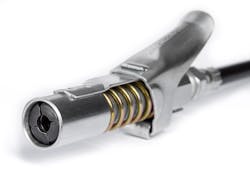Tool review: LockNLube Grease Coupler and Grease Coupler XL
The LockNLube Grease Coupler attaches to 1/8” NPT threads standard on all grease hoses and works on all Zerk fittings. It does not leak and will not pop off under pressure, says the company. After greasing, press the thumb lever to release the coupler from the Zerk fitting. Users can then grease their equipment with hands-free operation, without the mess or concern associated with leaking grease couplers or couplers releasing under pressure. The LockNLube Grease Coupler is 1mm larger in diameter than a standard coupler. It releases easily from recessed fittings, according to the company. With almost 4" of reach, the LockNLube Grease Coupler XL is a longer version of the company's original leak-free, mess-free coupler, especially suited for recessed Zerks such as those found on shielded PTO shafts, axles and U-joints.
Tool review
Eric Moore, co-owner of DeMary Trucks in Columbus, Ohio, had his technicians test out both the LockNLube Grease Coupler and Grease Coupler XL. He says the LockNLube couplers reduced the time and money he spent on maintenance, but did cause occasional frustrations with some of the techs as they made the switch from traditional couplers.
Prior to testing out the LockNLube Grease Coupler and Grease Coupler XL, Moore says they had not used a locking coupler on grease guns in the shop. “We usually end up just replacing the tips every several days, so they stay tight on the fittings,” he says.
For the most part, Moore confirms the LockNLube grease couplers were “very easy to use, except in tight quarters, sometimes the locking lever would get caught up, or keep it from being applied to the fitting.”
Moore says there was no special setup for these tools. “We simply threaded it on to our grease gun hose,” he says.
Moore says the grease couplers saw extensive use in the shop, and were used for predictive maintenance (PM) service on nearly every medium duty vehicle serviced in the bay. He says for basic PM services, there was no real time savings using the tools because it required techs to release the lock each time before greasing the next fitting.
He confirms, though, techs found the grease couplers most useful on the work truck equipment.
“On trucks with equipment that has awkward places where fittings are hidden or in pockets, the LockNLube worked excellent, with the tech being able to set the tip on the fitting and grease it quickly without having to try to balance yourself,” says Moore. He adds that this locking feature allowed the tech to apply pressure to the grease tip and apply grease at the same time.
For certain instances the grease couplers provided real time savings.
“We have a few Western Star vehicles that have boom style cranes with outriggers. Those vehicles were where we really found a great use for the LockNLube couplers,” says Moore. “With over 60 fittings on the crane and outriggers alone, it can get old real quick when the tip won’t stay on the fittings. Add on the truck fittings and it’s over 100.”
As an improvement, for the shop setting to get into tight areas, Moore says one tech suggested ”If it could have a button release, instead of a lever, that might make (the grease coupler) lower profile.”
Moore says overall both the Grease Coupler and Grease Coupler XL were great products. “The LockNLube Grease Coupler XL especially so, with an almost 4” nose for all those blind holes and pockets where fittings hide,” Moore says.
About the Author
Erica Schueller
Media Relations Manager | Navistar
Erica Schueller is the Media Relations Manager for Navistar.
Before joining Navistar, Schueller served as Editorial Director of the Endeavor Commercial Vehicle Group. The commercial vehicle group includes the following brands: American Trucker, Bulk Transporter, Fleet Maintenance, FleetOwner, Refrigerated Transporter, and Trailer/Body Builders brands.
An award-winning journalist, Schueller has reported and written about the vehicle maintenance and repair industry her entire career. She has received accolades for her reporting and editing in the commercial and automotive vehicle fields by the Truck Writers of North America (TWNA), the International Automotive Media Competition (IAMC), the Folio: Eddie & Ozzie Awards and the American Society of Business Publication Editors (ASBPE) Azbee Awards.
Schueller has received recognition among her publishing industry peers as a recipient of the 2014 Folio Top Women in Media Rising Stars award, acknowledging her accomplishments of digital content management and assistance with improving the print and digital products in the Vehicle Repair Group. She was also named one Women in Trucking’s 2018 Top Women in Transportation to Watch.
She is an active member of a number of industry groups, including the American Trucking Associations' (ATA) Technology & Maintenance Council (TMC), the Auto Care Association's Young Auto Care Networking Group, GenNext, and Women in Trucking.
In December 2018, Schueller graduated at the top of her class from the Waukesha County Technical College's 10-week professional truck driving program, earning her Class A commercial driver's license (CDL).
She has worked in the vehicle repair and maintenance industry since 2008.

